Brooklyn Comics and Graphics Festival: Collapsed Experience Special Post 1 (of 2)

(One week or so ago I traveled to New York City to attend the maiden happening of a new, small comics convention held in the basement of a church in Williamsburg, Brooklyn. It was a somewhat 'curated' event, presented by the local small press comics retailer Desert Island and the art comics publisher PictureBox Inc. It was held on Saturday, December 5th, though I stayed in town until Sunday, December 6th, in the home of Tucker & Nina Stone. I didn't meet up with Tucker until late in the day Saturday, and we spent basically the rest of my trip chatting and drinking coffee -- portions transcribed here -- and walking around the city, with an all-important stop at Manhattan's Kinokuniya Book Store, a key vendor of imported Japanese-language manga collections and anthologies. I left on the 7:15 train on Sunday evening.)
(What follows is culled from all parts of that trip, with transcription again by Tucker Stone, and manga images culled from recent issues of the Shogakukan-published anthology Big Comic and the Kodansha-published anthologies Morning, Morning 2 and Afternoon.)
***
Ah, Brooklyn! Fuck me in the mouth, what a day!
I could hear the drops chattering over the crowd as I ascended from the L line, concrete giving way to clouds, then a cheesecloth sheet of rain. It was alright. I'd never been to Williamsburg before, so I'd walked the entire path to the show in Google Street View; it was nice to be reminded that a real place is still different, in spite of technology, even if that reminder insisted on falling onto my head.
The show was divided into three locations, two of which I visited. The 'floor' of the show was in the basement of a church -- Our Lady of Consolation, no better venue for an alternative comics event in this country -- down a slick set of steps and over a pile of stacked umbrellas. I kept mine with me, so I could drip onto people's tables by way of introduction. Other attendees were less enthusiastic.
"Nobody'd better take my stuff," a woman behind me said, "if this thing's missing, I'm taking someone else's."
"That's bad karma," replied her companion.
"It's not karma. It's community."
***
[THE SETTING IS A FINE LIVING ROOM ON A SUNNY AFTERNOON]
JM: I'm excited about comics. Please, name a comic.

(You might not know it at first glance, but this is the new series from Minetaro Mochizuki, artist of the well-regarded survival horror manga Dragon Head - it's titled 東京怪童, which I can totally understand but I'm not telling.)
TS: Gogo Monster?
JM: I haven't seen a copy yet. Not in my own regular store, the big box book stores don't get it for another week. I'm looking forward to it. Taiyō Matsumoto's really fucking popular in Japan. I guess he's an alternative flavor kind of guy, but among the alternative flavor guys, he's around the top of the heap, and has the pull to get something like Gogo Monster released, like a deluxe hardcover. And when I say, "oh, this is a deluxe hardcover", something in a slipcase, that's because it's based off the Japanese edition.
TS: This is the one with those red edged pages?
JM: Yes! Not only is it the same as the deluxe edition published in Japan, that was the only format. Gogo Monster was an original graphic novel in manga, and while that's not unheard of, they're really hard to come by. Yuichi Yokoyama's Travel was another one, but I think it was published in France first. And that speaks to the economic power that Matsumoto has.
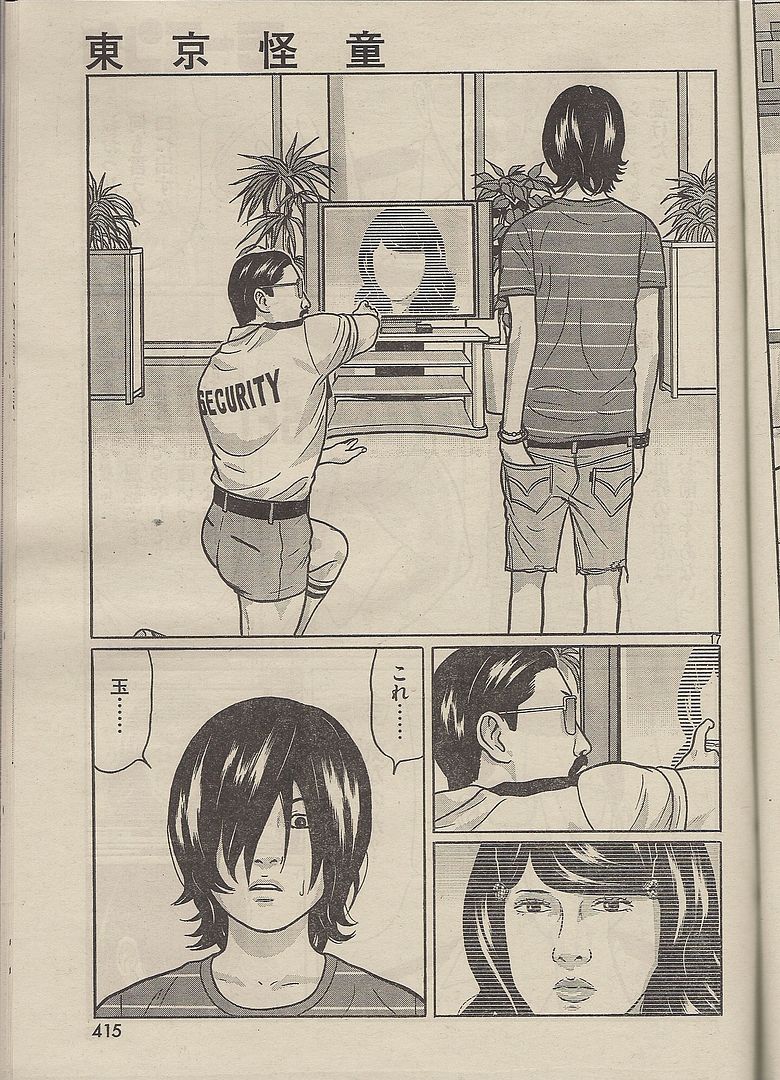
(Lots of very thick outlines and curved figures, with a hipster-ish '70s design sense; at first I thought it was an 'American' type of wacky comedy, but there seems to be a disorienting psychic plotline going, stamped with 'foreign' images.)
TS: It's old, right?
JM: It's from 2000.
TS: When was Tekkonkinkreet?
JM: Tekkonkinkreet is from the 90's. They started publishing that in [Viz's 'mature' manga anthology] Pulp.
TS: And it was the success of Tekkonkinkreet that got him the muscle to put out Gogo Monster in that fashion?
JM: Well, Tekkonkinkreet wasn't a success in America when they first tried to bring it here. That huge Tekkonkinkreet book that they have - that came out because of the anime. The first time they published Tekkonkinkreet in Pulp it went under before it was finished. They finished it in pamphlets, back when it was called Black and White. Then they put out a three volume collected edition that I don't think did very well.
They tried to put out another Matsumoto book called No.5. There's anecdotal stuff out there naming that as the worst selling book in Viz history. It was direct-to-collection in the late 90's, by the time the industry had just fucking crashed - it just didn't work. [EDIT: This is incorrect; the two extant volumes of No. 5 were released in 2002 and 2003.] Tekkon Kinkreet finally did well when the anime came out -- I don't know how well it did -- but they put it out in that all-in-one thing that you can just pick up the whole story, piggybacking on a movie.
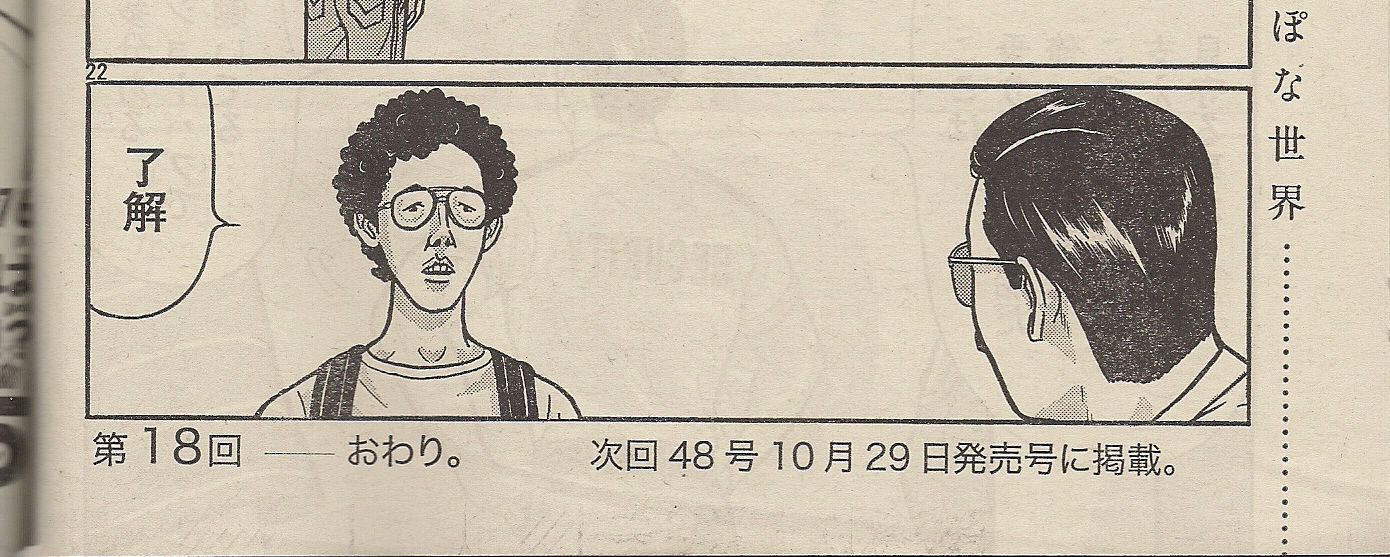
(And Napoleon Dynamite's in it too. Because it's beautiful to see a manga out there still waving the "fuck it, this'll never be seen outside of Japan" banner - Jon Heder, your reach is vast.)
***
Spermanga (Pakito Bolino)
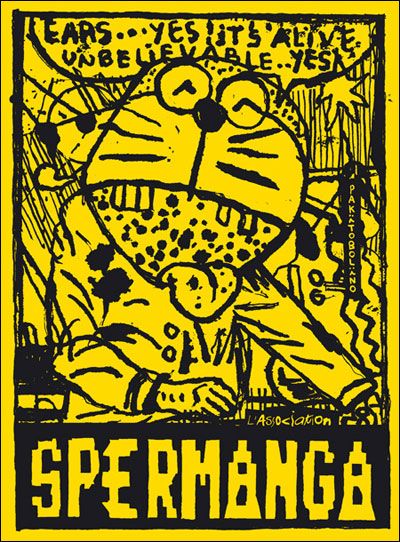
No sooner was I on the floor than I turned right and saw this: a big yellow 84-page hardcover slightly smaller than Gary Panter's Jimbo's Inferno -- which is to say pretty damn big -- with visible text in English, wrapped up tight in plastic on a table of sprawling silkscreen prints. This caught my eye - it's silly to deem a huge $40 hardcover comic of this type 'conservative,' but the disposition of the table was such that anything not evidently handmade stood out as controlled.
And then, as you can see above, the friendly logo of L'Association, that most revered of French alternative comics publishers, still without an operational website in the twilight of the '00s. Plus:
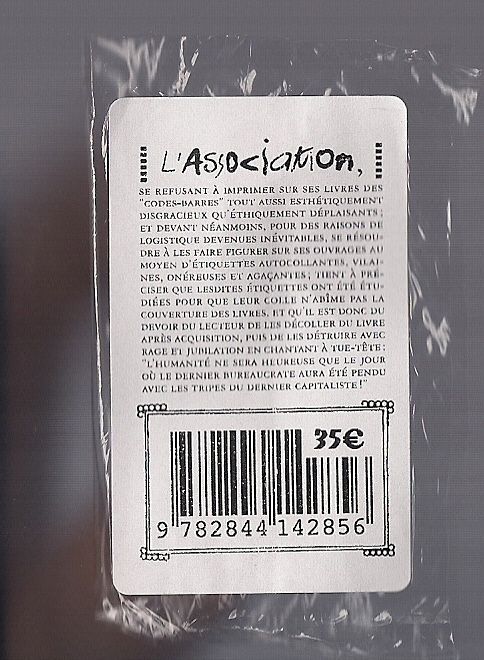
The infamous L'Association bar code sticker. "Humanity will not be happy until the day the last bureaucrat has been hanged with the entrails of the last capitalist!"
I'd never heard of Spermanga - turns out it's a 2009 release. Moreover, it's something of a titanic team-up between artcomics forces, being a collection of work by Pakito Bolino, co-founder (with Caroline Sury) of the famed ultra-small press comics and prints collective Le Dernier Cri, active since 1993, when Spawn was huge. It was Le Dernier Cri's table, filled more with Graphics than Comics; I spotted a few copies of the most recent (8th) edition of the publisher's Hôpital Brut house anthology, a handmade, proudly garish, disheveled, different-paper-stock-seemingly-every-other-page affair that makes any given Kramers Ergot read like Y: The Last Man.
Sadly, there were no copies of the group's 2006 dvd extravaganza Le religions sauvages, the extended trailer for which seems ripped right out of my older relatives' nightmares of Satanism as a tone; apparently all copies were reserved for Le Dernier Cri's current exhibition at Brooklyn's Cinders Gallery, presumably the reason why they were in town for the show to begin with.

This is not an easygoing book. Granted, you can certainly list similarities with other works -- Panter seems to glide right alongside Bolino's drawings, and there's an opening lineup of mostly extraneous fantasy characters akin to Brian Chippendale's similarly huge Ninja -- but mark my words, this is harder and meaner than all the rest.
Ostensibly a compilation of four short stories, all of them somehow concerned with weird mutations and violent struggles, Spermanga mostly laughs in the face of literary appeal, but only after a good tease. It's entirely in English -- remember, this is a French publication -- generally tortured beyond all but barest notion of comprehensibility. Panels are laid out in clean, large arrangements, often failing to make narrative sense in relation to one another. There are many action scenes (often against Nazis) and dramatic situations -- indeed, some of the English seems to have been selected entirely based on how cool it sounds -- thwarted by Bolino's habit of drawing characters differently from panel to panel.
I don't mean an expressive, pliable approach to figure work by that. I mean almost totally different character designs as the stories continue, no acknowledgement, no 'hints' - pure capricious feeling. Maybe all the stories are one story. Maybe they're all the same story. Maybe it's just the pleasure of drawing busy destruction, swastikas decorating many panels as they would a freshly carved desk, and if you think that's childish I think that's why it's done, because this art is opposition, to taste and decorum, and maybe the simple agreed-upon idea of how adults act.

Yet I think there's more. This is a beautiful work, not just for the dotty and scribbled urine coloring that often seems to be drawing its own secret comics behind the lines - no, what gets me is how Spermanga eerily evokes the sensation of drinking in a fabulous work you can't possibly understand, i.e. a foreign work. There are many icons in here -- Doraemon, Mega Man -- a small hinge of familiarity made weird not just by Bolino's perversion but by being, by acting - really, aren't all Doraemon comics and cartoons a bit strange when all you know is a symbol?
This is the work's submerged theme. "Sper[m]" for the sick appeal of the drawings, "[m]anga" for the alien quality - I suspect it's no coincidence that Le Dernier Cri had worked with several Japanese artists over the years, even as the 'mainstream' of French comics has reacted to the growing power of popular manga with occasional fits of terror (see: Asterix and the Falling Sky, a real Chicken Little album). By its barely-there English and obscure images, sometimes crackling into amazing sensations, Spermanga forces the reader away from storytelling illusions and demands interaction with the notional 'story' you know is going on but remains somehow out of your reach. I guess the pictures in Big Comic are slicker, but the feeling is quite the same; Bolino exploits this foreignness as illustrative of the gulf between an artist's pleasure and a reader's subsequent understanding.
Speaking of which, I didn't know that Bolino himself was running the table. As he handed me the book -- which he would eventually sell out of -- he breathed in and summarized the aesthetic posture of the entire festival.
"These are my drawings."

***
TS: Binky Brown Meets the Holy Virgin Mary.
JM: I have the Binky Brown Sampler. Do you have that?
TS: Nah, I got the original version of it.
JM: The 1970's comic book?
TS: Yes, that's what I have. It's this old and beat up copy from somewhere, it's not the sampler. I can't remember how I got ahold of it.
JM: Yeah, in the Sampler, it's clear that the Holy Virgin story is the draw. It has an Art Spiegelman introduction. The McSweeney's book has a different Art Spiegelman introduction, a nice afterword, but the main thing is how huge it is. They shot it from the original art, in color. All the white out is on it, all the paste over is on it, all the stuff that usually disappears is on it. When you look at it, there's a distance from it, where you see the mechanisms that went by to create it. I haven't read through it yet to see if the sensation is different, being so aware of its creation. That's an increasingly common technique these days--Anders Nilsen doing his philosophy comic [Monologues for the Coming Plague] and scratching out the words he didn't like - it emphasizes the mark-making aspects of comics, the construction aspect of it.
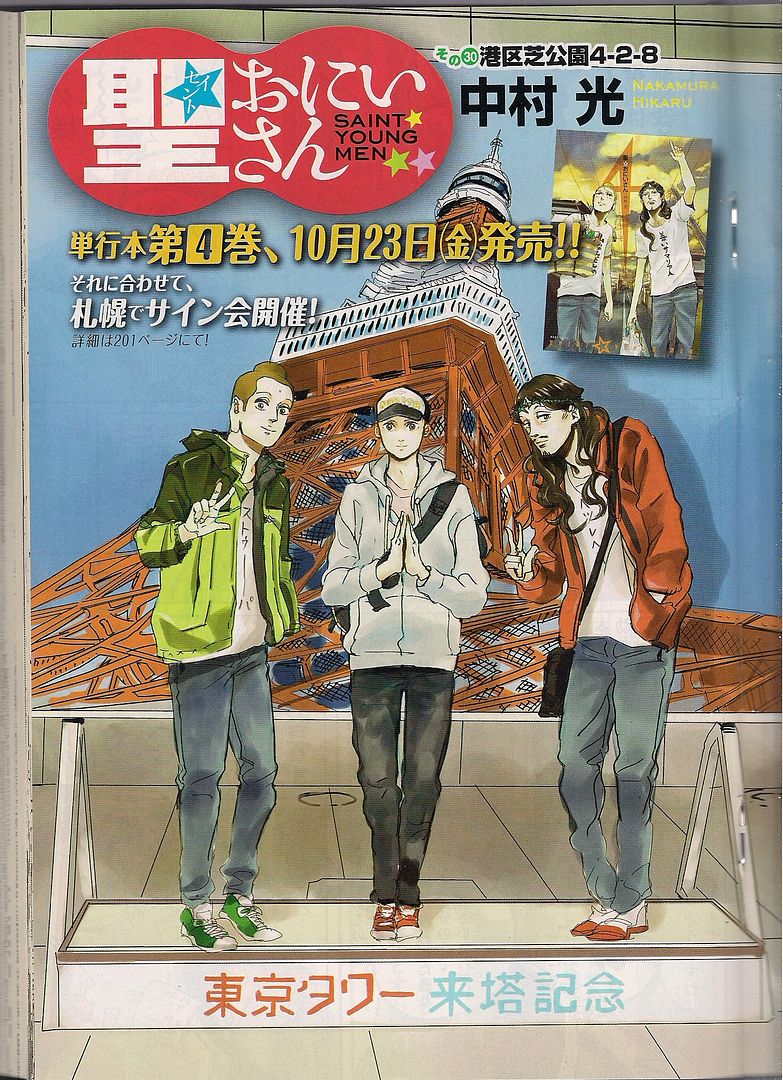
(Yep, the indie-flavored Morning 2 really does have a serial wherein Jesus & Buddha are cool cats touring Japan: Hikaru Nakamura's Saint Young Men. I think I saw all these people on the show floor.)
TS: Who created the new Binky Brown cover? The imitation diptych thing?
JM: I don't know. They have the original cover stuck in the middle of it.
TS: It's about the size of a large postage stamp. It's tiny.
JM: It gives it a medieval look. You've read it, Binky Brown is about religious and sexual aspects of his obsessive compulsive disorder. It's fun reading that and remembering Alison Bechdel's Fun Home, which also has a segment on OCD, seeing a lot of the same spice come from a non-religious perspective. It's more of a nebulous, almost science fiction-like "Cosmic forces are going to destroy the world if I don't touch the table with both my hands."
TS: It seems like that's a stereotype of cartoonists, it's clearly a classic one of readers, but the OCD tendencies of having to actually draw all day, an act that's got so much control and repetition, physically. That's another one.
JM: Well, Alison Bechdel apparently constructed the entirety of Fun Home from books of photographs, archives of a lot of her life. I think she's mentioned in interviews how it was kind of channeling her energies in a more creative direction. It's a very obsessive work of a construction, I think she photoreferenced the whole thing, playing every character and every panel.
TS: Jesus Christ.
***
The show was busy. You've heard that. I bet you've heard a lot of stuff, since I'm filing this report more than a week after the fact. That's really it though - it was an oddly dense show, unified in a way that larger, established 'indie' shows aren't. You know what to skip over with those.
This time I found myself stepping around the room for an hour before reaching the back half of the basement. Part of that's because it was really crowded, but it also seemed like each table had some special potential, even though I recognized a lot of the wares in the end. This was the first BCGF, so there wasn't a lot of hype going around, no hot debut books planned or expectations in place with which to gauge the tenor of the scene. Instead, there was collective presence, of which more will be said later.
As often happens, I was especially drawn to the exhibitors from outside North America, little tastes of bigger comics places. Bries of Belgium had what looked to be a reduced stock, mostly wordless or English-language books dotted with popular sellers from prior shows, like Olivier Schrauwen's My Boy and Nora Krug's Red Riding Hood Redux. Corraini of Italy brought complete sets or singles from its pamphlet-format Un Sedicesimo line of artist showcase books. As mentioned above, Le Dernier Cri occupied French space - and only in a show like this could an operation like that stand in for French comics!
Inoculations against memorizing the layout of the East Coast minicomics area. And, as usual, there's another type around too...
***
TS: Tales of the Beanworld. Are you actually keeping up with the new Beanworld?
JM: No, I haven't kept up with the new Beanworld.
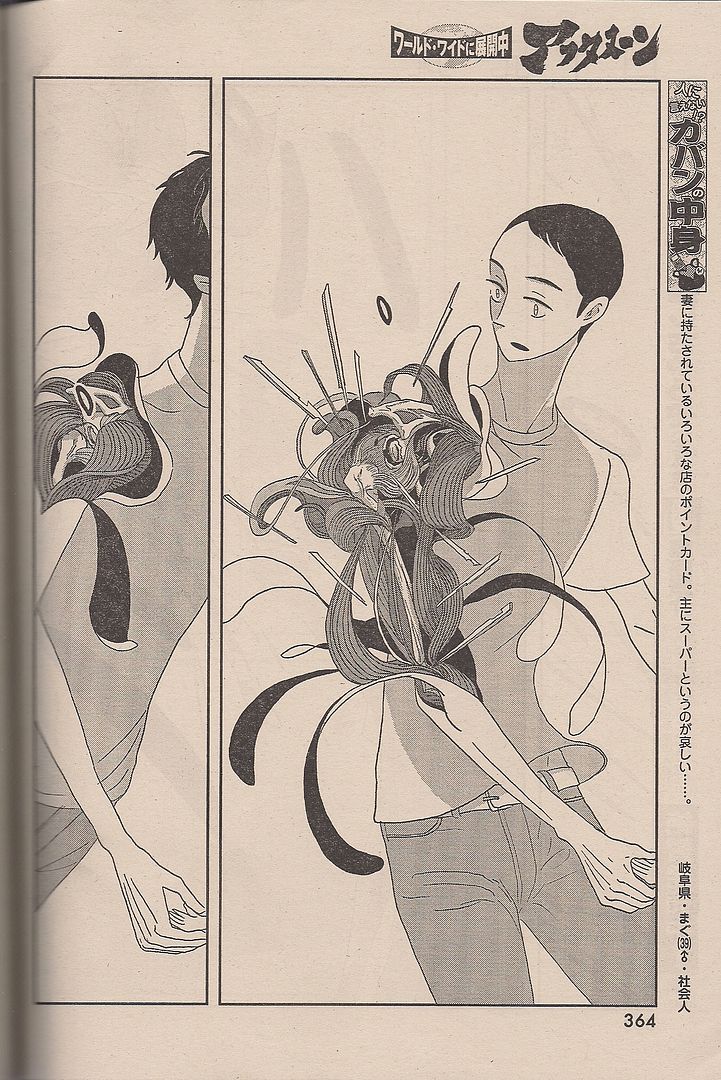
(This little showstopper comes courtesy of Haruko Ichikawa, an artist I've never heard of before.)
TS: Have you gotten any of the reprints?
JM: I've got the holiday one that they put out, the color one [Beanworld Holiday Special]. Beanworld--have you read Beanworld at all?
TS: I have one of the 1995 Beanworld Press collections, the comics sized trade. I don't know how much of that is in these new collections. That's the only one I've got, I've read that quite a few times.
JM: Beanworld's an interesting comic. I've said this before, but it's almost like a Mat Brinkman monster comic reimagined as a Sunday newspaper strip of gag stories. I like that his art has not fucking aged a day, that it even looks better now than it did before. It looks like a clip-art webcomic - I think I'm just repeating stuff I've said on my website. Now I think he's actually using clip-art to make it.
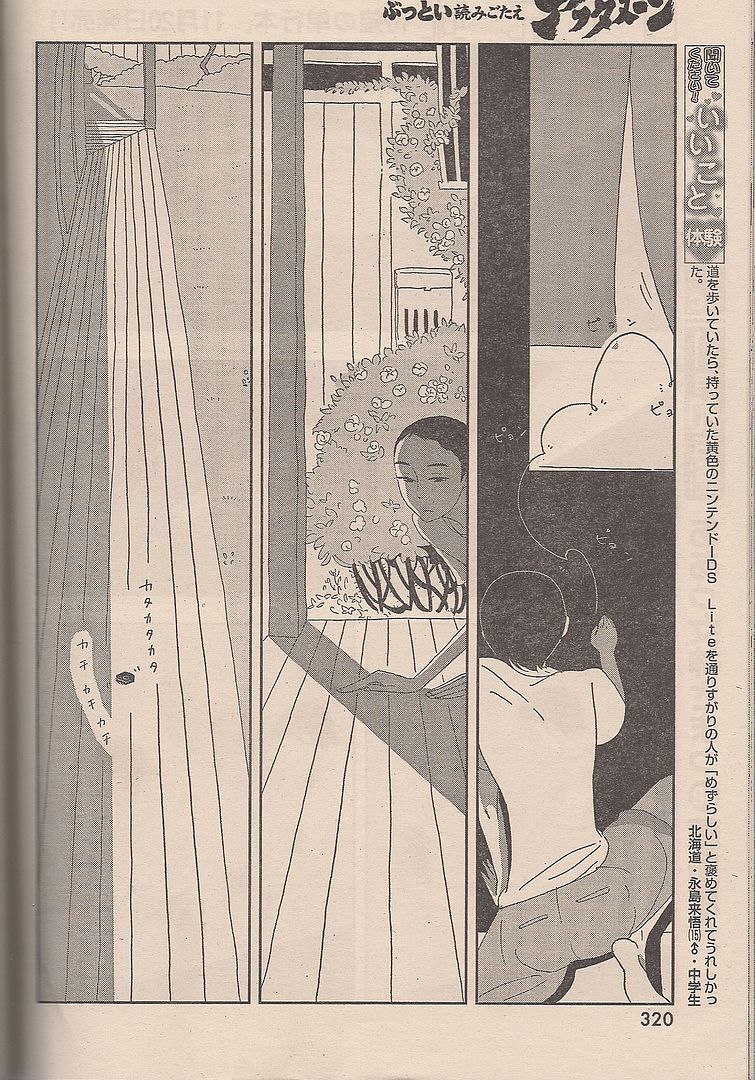
(A very sinuous, elegant approach, stretching a minimal landscape until reality near transparency.)
TS: I wonder - if you look at some of the art in Fight or Run, Ganges #2, there's a very similar behavior pattern to those video game avatars in [Kevin] Huizenga's comics and the Beanworld characters. I get more of a sense of depth from Ganges, mostly because I just think Huizenga's a better cartoonist - well, maybe just a better illustrator, in that his characters have more of a shape, they've got weight to them. Beanworld always struck me as a sort of half-newspaper gag, half-education comic.
JM: Thing is, it's a faux-education comic. It's deliberately creating the sensation of an education comic, a whimsical, metaphorical thing. I wonder what Frank Santoro makes of Beanworld?
TS: Hh. That might be interesting.
JM: Because Frank loves a lot of the other comics, the older comics, and how they relate to the process of "art" comics today. I wonder what he makes of fucking Beanworld and Larry Marder.
TS: I wonder what anybody makes of Beanworld. People talk about in the sense that they like it, but I don't know that I've ever read anything about it that's gone beyond that, something that goes beyond to the "I like it because of..."
[TUCKER GESTURES TO INDICATE A PAUCITY OF SUBSTANCE]
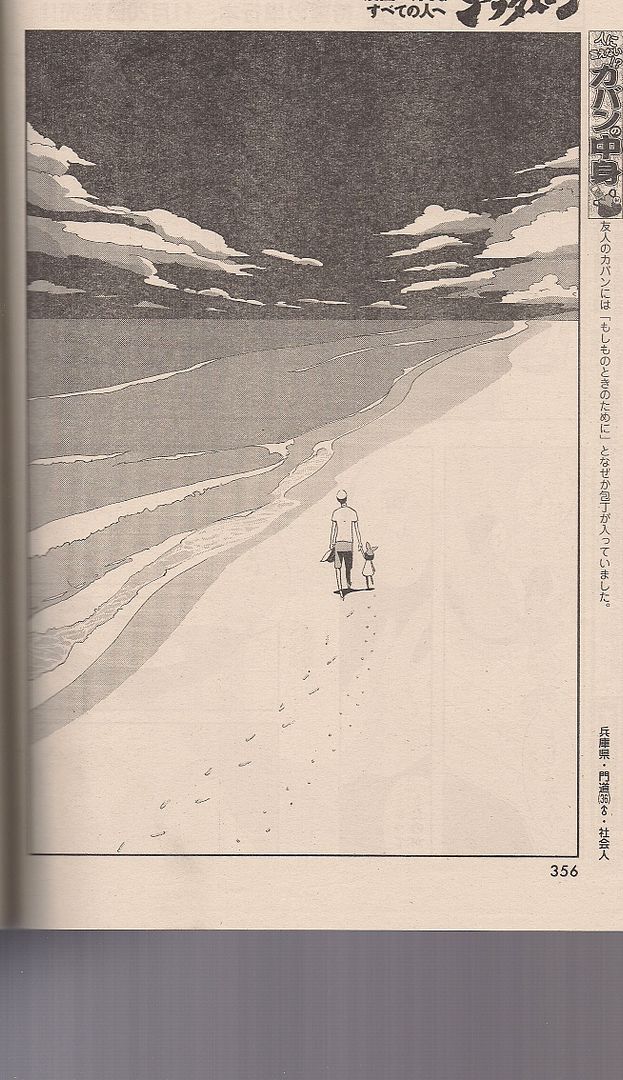
(Balance, poise, the subtleties of overwhelming landscape; kinda Ukiyo-e, like Hokusai, a manga artist from back when it meant something different.)
JM: I haven't looked into the old writings of the old Comics Journals, but I bet there's something about old Beanworld. There's been nothing since it started back up, no reappraisal of it since it came back. I would like to read that.
TS: Is this third one [Beanworld: Remember Here When You Are There!] the first new material?
JM: No, the holiday special was the first new material. This third volume is the first big book of new material. And he did a Dark Horse Myspace thing as well.
TS: Yeah, I didn't read any of those.
JM: Here's something. We've been talking about how I don't read any fucking comics, and I'll admit - the kind of reviews you do? I don't read any of those comics. But since we're talking about me not reading comics, how about you? Do you read any webcomics?
TS: Not really? Well, let's see. I read Bodyworld when it was coming up. I read Achewood, the Kate Beaton stuff, Dinosaur Comics...
JM: You mentioned the Dark Horse Myspace thing [EDIT: No, I did] - do you find it more difficult to "check in," because it's not physically in front of you at a store? Is it the Wednesday mentality? Trying to keep track of the "new" comics? I know there's RSS feed.
TS: Part of it is that I stopped subscribing to so many webcomics when I was no longer spending all day sitting at a computer. I read a lot more webcomics at my old day job, just completely random stuff, even things I didn't even care for. Lots of Zuda stuff, Act-I-Vate stuff - I actually do keep up with some of the Act-I-Vate stuff. Power Out, Loviathan. But I was a lot more active with that when I spent 9-10 hours a day sitting at a computer, on the job. Having a bunch of RSS feeds that pop up with new content every five minutes is a lot easier to keep up with when you're on a computer all day.
But when you're not spending all day at a computer, coming home to 70, 80, 90 things - I couldn't handle it. It's too much, and when a culling process starts, it's not a "I'm going to cull some of the webcomics based on what I really like," it becomes a "I'm not going to read any of these things" via this format anymore. Now it's checking on Achewood once a week to play catch up.
JM: Ah, see? That interests me, that coming home to a raw list of webcomics at the end of the day - it's a little like the big blast of pamplet comics every Wednesday.
TS: It is, but it isn't. Because it's constant, it's every single day...
JM: Is it oppressive?
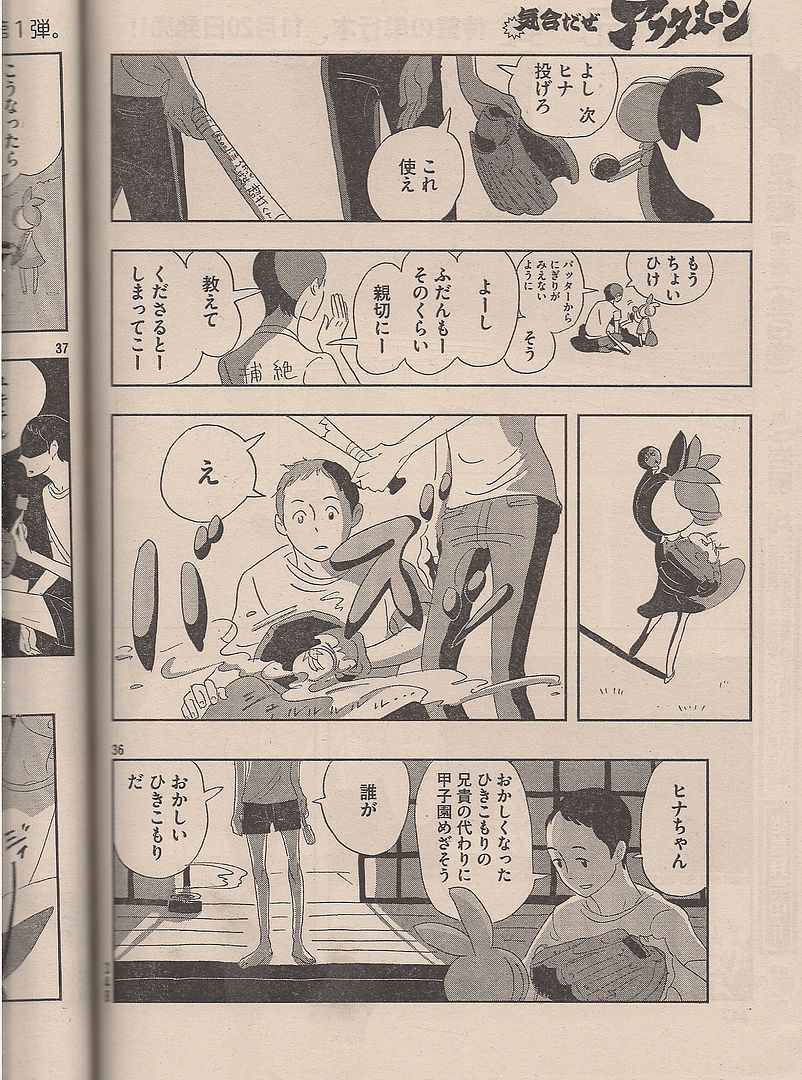
(From what I can gather, this is a concluding one-off story of an annual sequence of four, something about a ball player with a bum shoulder that walks around with faceless little girl. She later explodes; but then, so might any given page from the looks of it.)
TS: I think it has a sense of being oppressive, and there's this - there's a portion of interaction beyond the comic, with the online presence of the cartoonist coming with them, and I don't actually care for that. I was a pretty consistent newspaper comic reader growing up, just reading everything - and there was no interaction with the people involved. I didn't end up online seeing them say "go fuck yourself" or "I fucking hate this guy."
JM: I think that's kind of a taboo with newspaper cartoonists, like when you go on Comics Curmudgeon and he's interacting with the guy who draws Slylock Fox [& Comics For Kids]. It's kind of odd seeing that kind of interaction with newspaper cartoonists.
TS: I was a pretty obsessive reader of Comics Curmudgeon.
JM: I was too. I can't even recall a reason why I stopped, I just got out of it.
TS: Same here. The active relationship with online cartoonists is one that I just don't have any interest in. That's part of the charm with mainstream superhero comics that alt and art doesn't have either, there's more of a distance. I don't need a relationship with the people who create the stuff that I'm into. But because comics are small, you end up getting to know these people - and hey, in some ways it's a benefit. It's nothing against these people, they're regular people like everybody else. It just makes for a weird relationship with the people who create the art, it's the classic case of when your buddy makes a CD, gives it to you, and then won't stop calling you to find out what you think of it.
JM: I was thinking about webcomics because I wrote that manga thing earlier this week, and one thing I totally didn't address was webcomics. Part of that was because I was focusing on perceptions and qualities of print publishing, and I think webcomics may lack some of the biases that print has. It's not going to be a "here is manga, and here is comics." It's a little freer in that way. I suppose it has to do with the economic requirements of print, that there aren't any economic requirements for webcomics per se because - a lot of people don't make any money doing it.
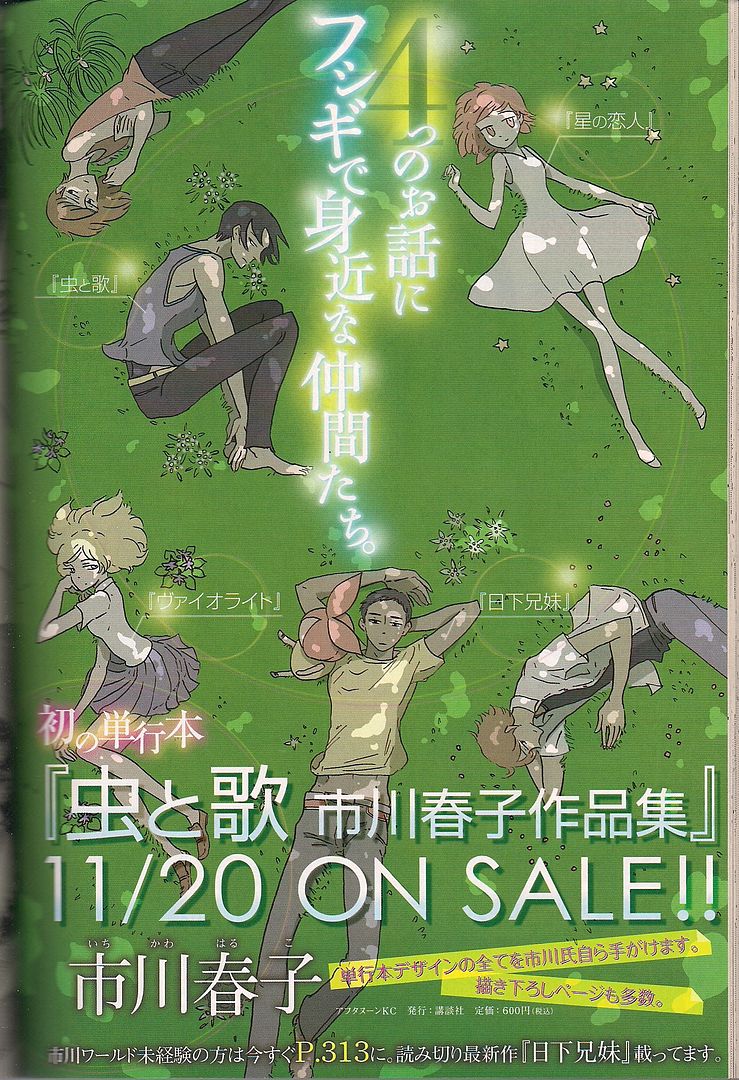
(House ad. Green 'n pale, The title is Mushi to Uta. Dig that heavenly neon.)
TS: Have you seen those things where people are constructing webcomics through an interface?
JM: No.
TS: A couple of people I read are doing that, it's a sort of social networking interface where one makes a webcomic out of pre-constructed parts. It's mostly gag cartoons, three panel things, I haven't looked into it too deeply. The creators can then embed it on their own websites, while all of the comics are posted on the main website. I assume there's some advertising model, it looks free. I have no idea if it's popular or not.
***
Shaky Kane's A-Men and Black Star Fiction Library (USA Edition) #1 (Shaky Kane & co.)
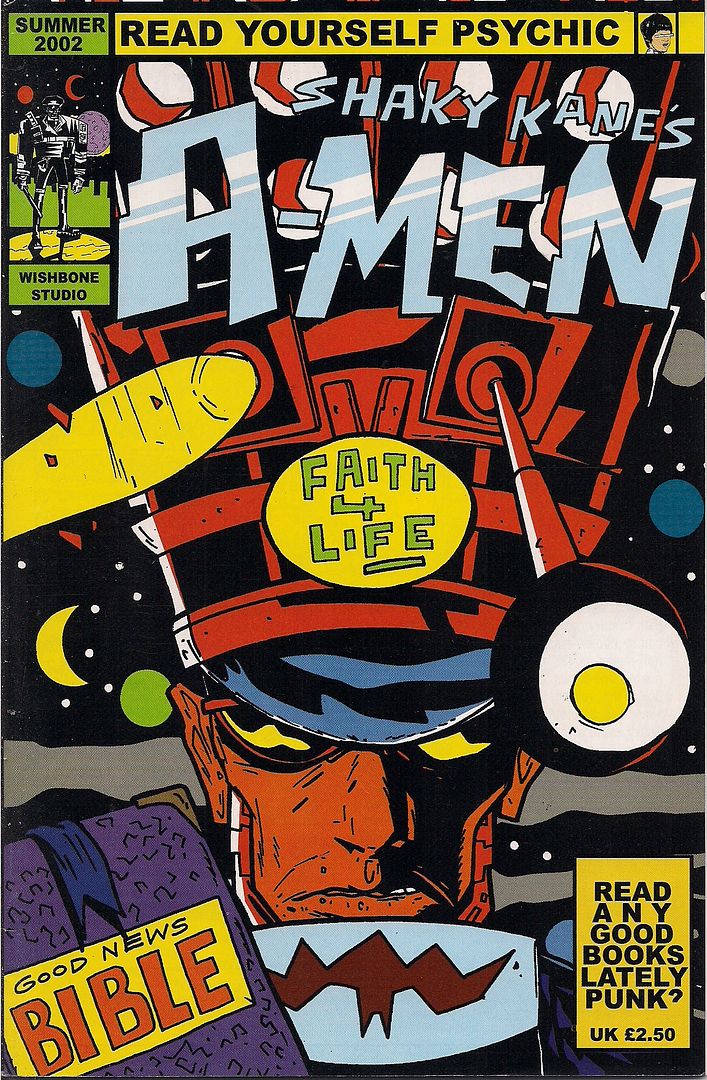
...Frank Santoro's longboxes. This time there were five or six of those suckers set up, including an honest-to-god quarter bin, injecting a dose of old-timey hotel ballroom local con feeling into what was pretty much exactly that, albeit devoted to Comics and Graphics of a curated-ish sort.
As it turned out, I doubled up and got part of my overseas experience out of the longboxes themselves with these two pamphlets devoted to one Michael Coulthard, aka: Shaky Kane. While part of that especially fertile batch of British cartoonists that entered comics in the mid-'70s -- including artists that later specialized in writing, like Alan Moore and Grant Morrison -- Shaky Kane has remained somewhat obscure, despite contributions to NME, 2000 A.D., Revolver and Deadline. Do note, however, that he'll soon be joining up with David Hine for a new Image series, The Bulletproof Coffin, right up there on my front-of-Previews 2010 anticipation list with Brendan McCarthy's Spider-Man/Dr. Strange miniseries, perhaps the Ditkovian counterbalance to Shaky Kane's wildly idiosyncratic processing of Kirby's mighty influence (among others').
Needless to say, this individuality has attracted Frank's attention -- Comics Comics #4 boasted a pertinent cover story/interview feature (along with an unrelated essay by me, full disclosure) -- and thus a few tricky-to-find items popped up for sale. Take Shaky Kane's A-Men, a collection of late '80s strips first seen in Deadline - it was published in 2002 by the artist's own Wishbone Studio (with financial assistance by the Exeter City Counsel as part of an animation festival), its source materials scanned from back issues of Deadline itself, and its rights situation apparently not totally sorted out, as Shaky Kane himself asserts. Still, the work had to get out - bah, it's nearly as handmade as Hôpital Brut!
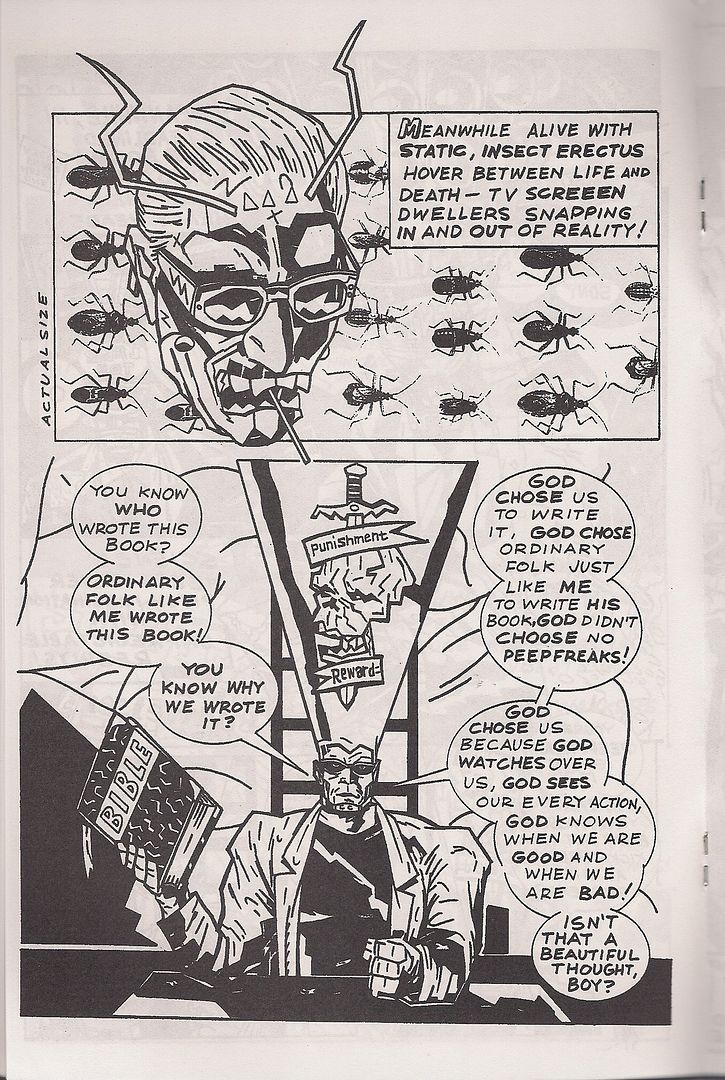
A-Men is a deeply odd strip, although I guess any of the Deadline features that weren't Tank Girl might seem a little off today. For all the Kirby kreases and Dalek imagery a lot of it's a Judge Dredd riff, with the titular police-plus force smashing into a nasty, secular society (Reagan's Day is duly celebrated as April Fools') in parodically 'heroic' fashion, vignettes detailing their origins and...
Well, initially telling of their adventures, but very quickly opting to just have the A-Men talking about themselves, while scenes of a wider society occasionally swirl. Eventually a hardboiled detective character enters the story, seemingly from another strip entirely, but it turns out it's really Shaky Kane himself, who then assassinates Jesus Christ in outer space as a means of breaking the A-Men's spirits and ridding his mind of their foul exploits.
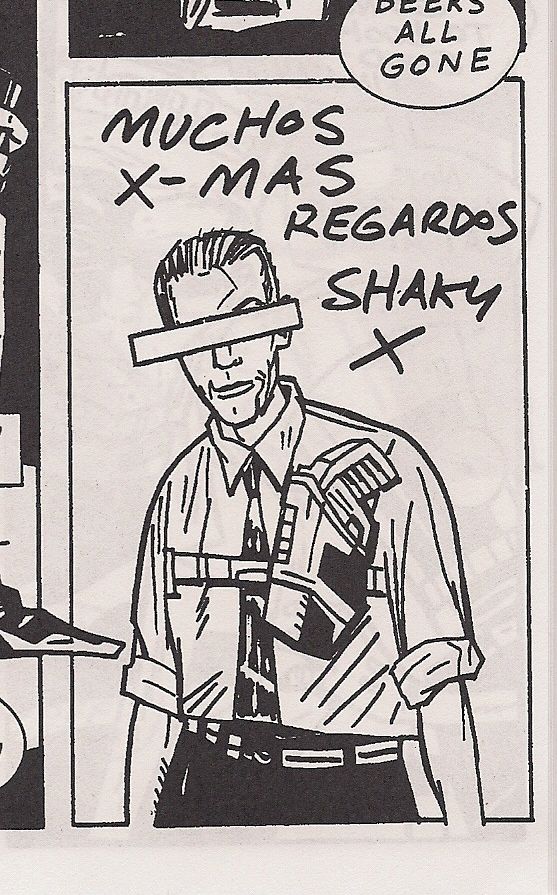
I can't imagine this impression was easy to get from Deadline's initial run, but A-Men works best as an off-the-cuff, self-reflexive expression of artistic evolution over the course of a project, with the increasingly monologue-prone anti-heroes offering the artist ample opportunity to replace action comics storytelling with contained page designs and splash images, all while his near-immediate disinterest in plotting complications from his satiric premise develops on-page into his own character's desire to end the feature in a good two-fisted manner.
It all matches the relative lack of polish to the art, very much sorting itself out as it goes along (and always a bit fragile, emotional in its classic pop comics evocation), along with the hodgepodge quality of the pamphlet collection, which 'completes' the air of it in that way. Surely it seems more sympatico with the silkscreen dreams and newsprint images of the BCGF than the polished comedy sketchings of recent Tank Girl outings.
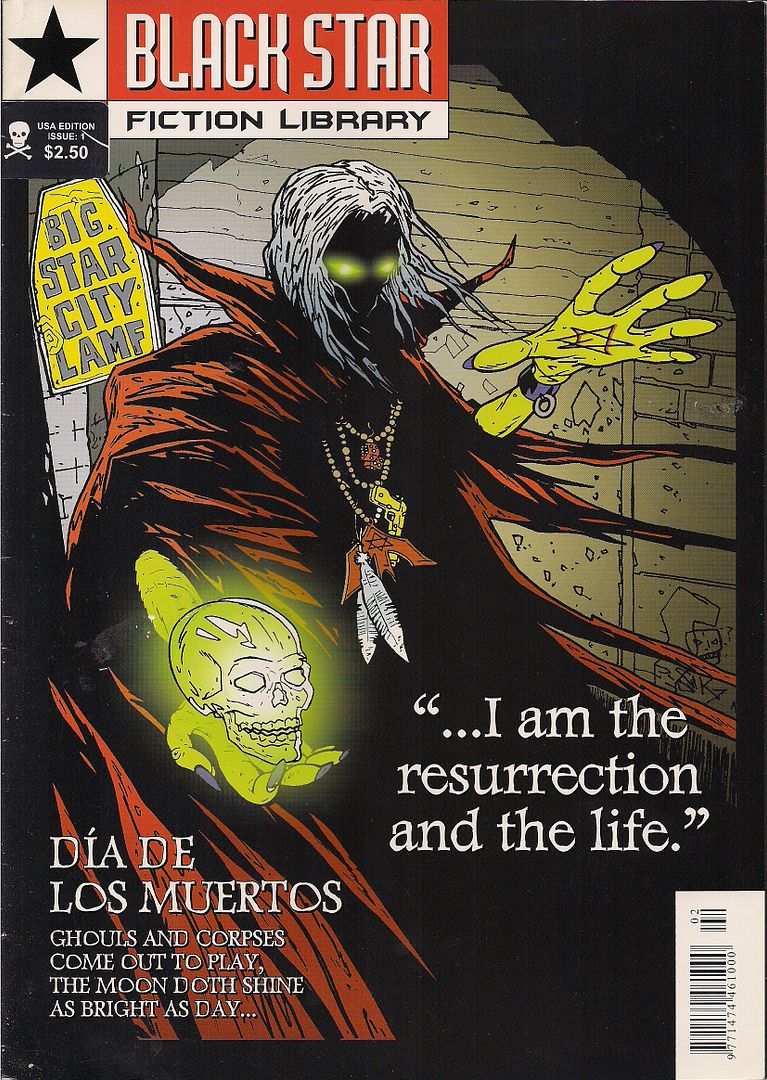
Around the time the A-Men collection rolled out, Shaky Kane was also working on his own slicker endeavor, an anthology comic that eventually saw release in the U.S. as a one-off glossy magazine featuring two color stories drawn by Shaky Kane, and a headlining supernatural character Scratch -- an acid casualty variant on the Crow or Spawn -- created and written by the artist and one Ian Porter, also the magazine's editor (I think - there's no such credit given).
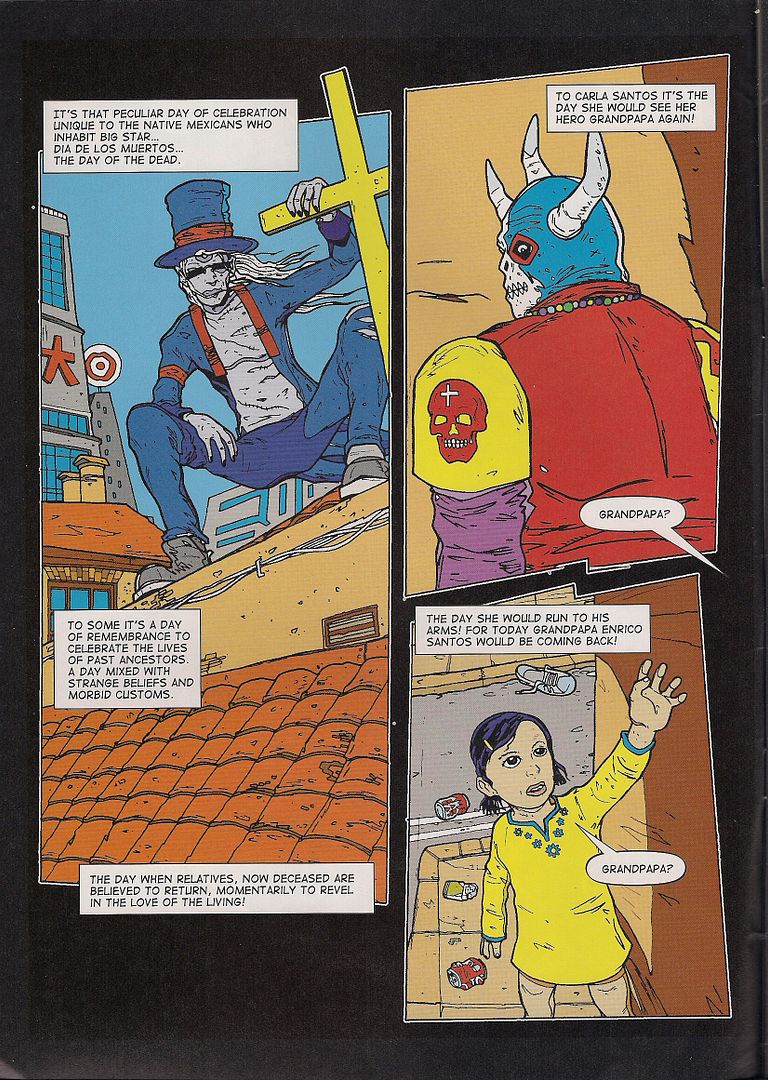
The first story, colored by Ali Jen and reprinted from the second (and final) U.K. issue, sees Scratch revive a shot-dead policeman (always with the police!) for the sole purpose of rubbing his face in all of his evil deeds. It's a surer work of graphics, clearly evolved from the Deadline stuff, with single pages rarely featuring more than three panels at a time and scenes of memory stretching across double-page layouts, big & bold images the key.
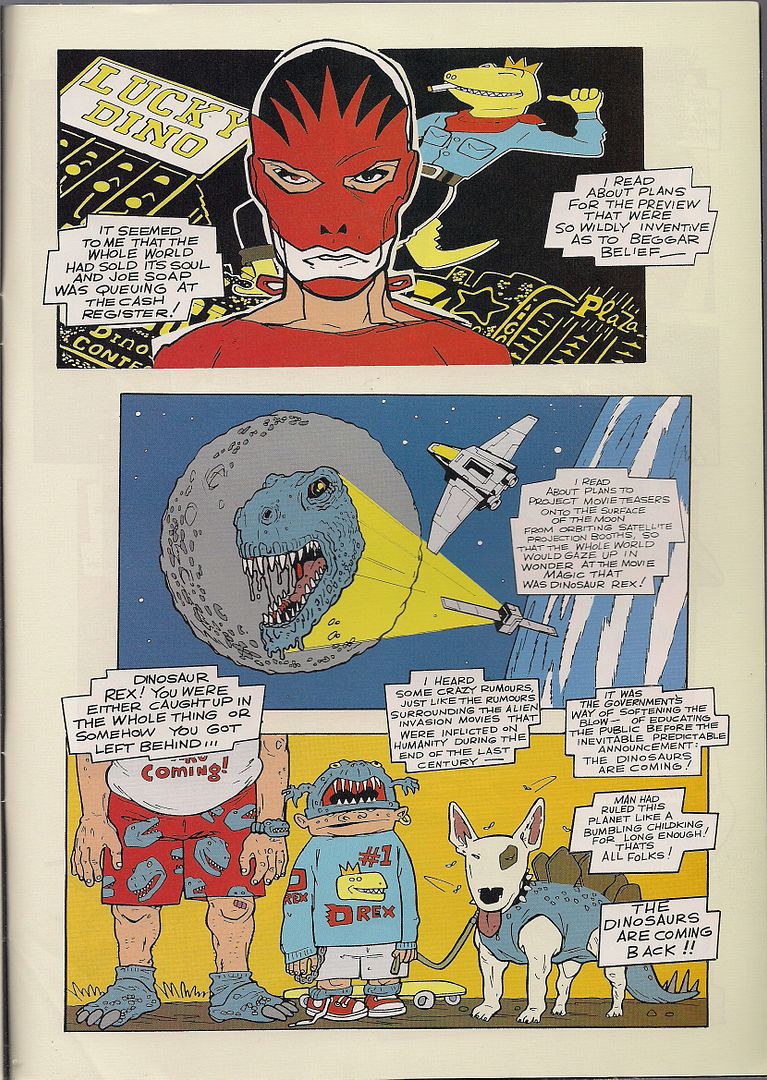
The second story seems to have been reprinted (and probably colorized, by Tim Seelig) from a prior Wishbone Studio release, The Dinosaurs Are Coming! Returning to the monologue style, the artist presents a masked consumer ranting about the latest media fad to hit society, which might as well melt into the possibility of wide-scale catastrophe, since news is entertainment anyhow.
It's a terse, funny piece, good enough that I'm interested in tracking down a copy of the Shaky Kane humor magazine Lazy Frog, to say nothing of the artist's most recent completed project, Shaky Kane's Monster Truck, a 50-page illustration with text that promises to extend the artist's spread-out designs well beyond their prior limits, and probably out of the confines of a longbox, however well tended to. Again: summary of the show.
***
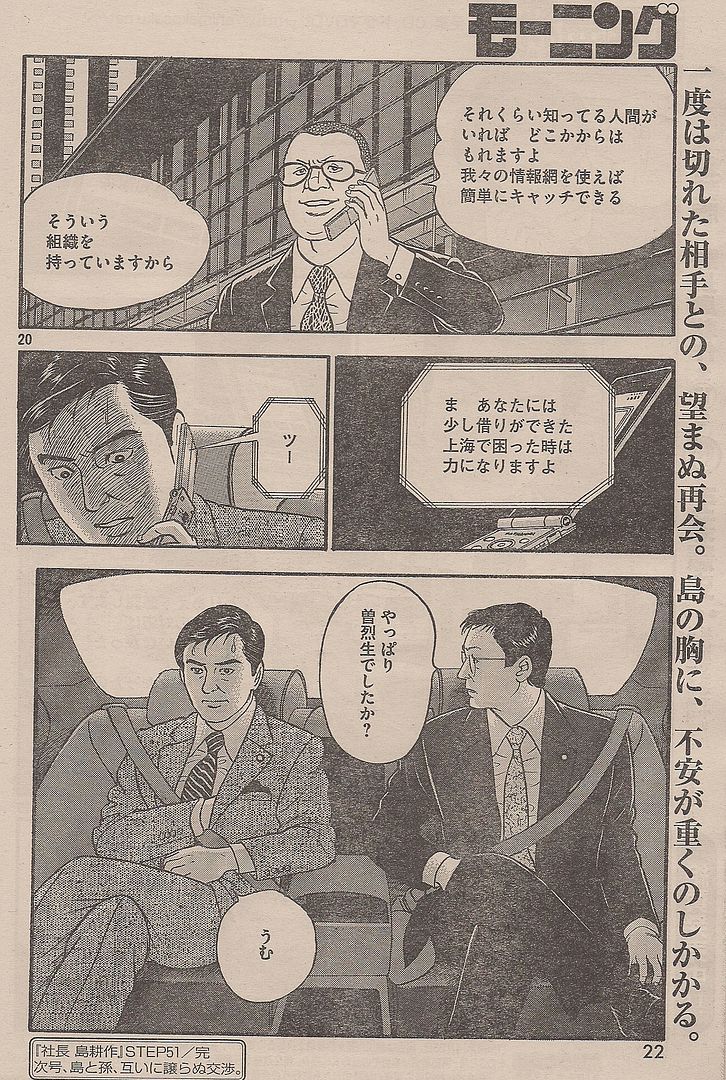
(This is from that salaryman manga Carl Horn mentioned the other day, President Shima Kosaku -- or President Kosaku Shima, if you switch it up Western-like -- the latest in creator Kenshi Hirokane's Shima Kosaku line of grown-up comics about a guy rising in rank through the Japanese corporate system via the power of being an awesome model employee we all should all think of at our desks, starting in 1983 with Section Chief Shima Kosaku, then moving on to Division Chief Shima Kosaku, Managing Director Shima Kosaku, Executive Managing Director Shima Kosaku, the current President Shima Kosaku, then probably Author and Television Pundit Shima Kosaku, Catatonic Inpatient Shima Kosaku and Neutrino Cosmic God Shima Kosaku, which will still somehow involve board meetings.)
TS: One Model Nation?
JM: I haven't seen it yet. I suppose there should be a disclaimer on my weekly lists. Everything I write on my website, I don't necessarily buy. It's just things I think are interesting, brought to people's attention. Occasionally I get the idea that people think I buy everything I write on this, like "wow, that's really expensive."
[DOORBELL RINGS]
TS: Huh? We should probably move to another room.
NS: Is that alright? She's having a hard time.
TS: Fine.
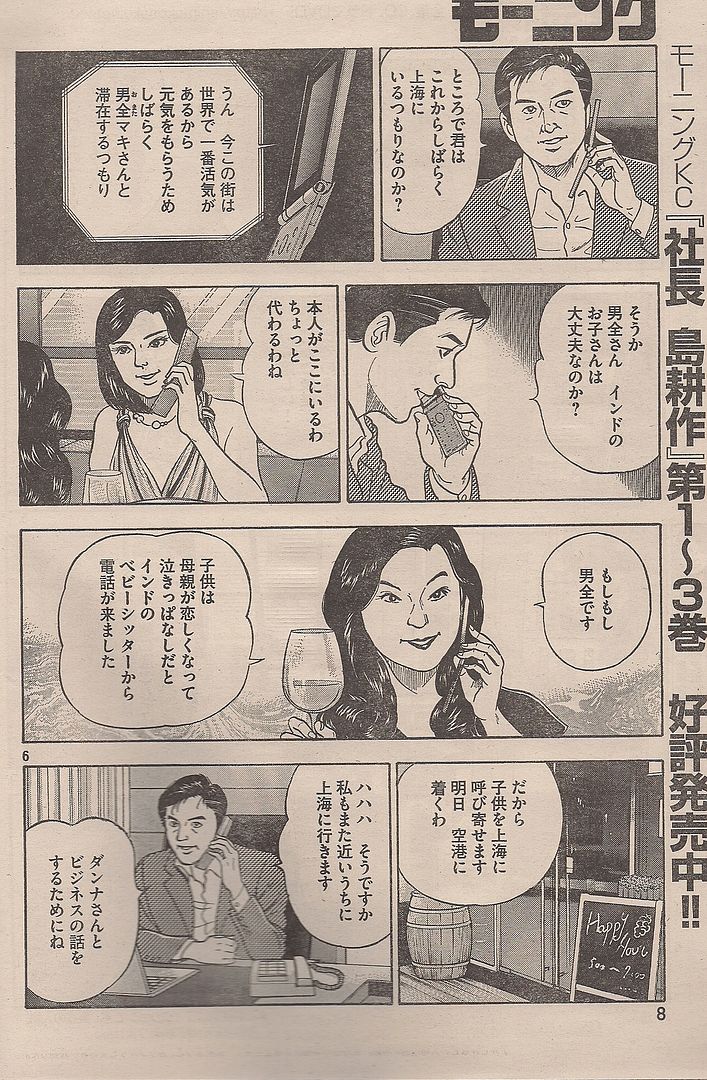
(Another breathless, hot-blooded scene as only Shima Kosaku can bring it.)
[LONG PERIOD OF SILENCE]
JM: How dare you give up on Cromartie High School at volume 4!
TS: I've had trouble finding them.
JM: I had the same problem.
TS: I think it'll be an Amazon is my friend thing on that one.
[DOOR SLAMS]
TS: Slam Dunk you buy. Popeye you buy.
JM: I'd never read the old Fantagraphics collections. This particular volume features the Sea Hag storyline, which was in The Smithsonian Collection of Newspaper Comics. It's a landmark thing, I don't know if you've read it.
TS: I don't. I've seen it.
JM: It's really cheap online, you should definitely check it out.
TS: I always mix it up with the other one, I see that one all the time.
JM: A Smithsonian Book of Comic-Book Comics, which is okay. It's a Golden Age collection, it's okay. Not near as good as the other one.
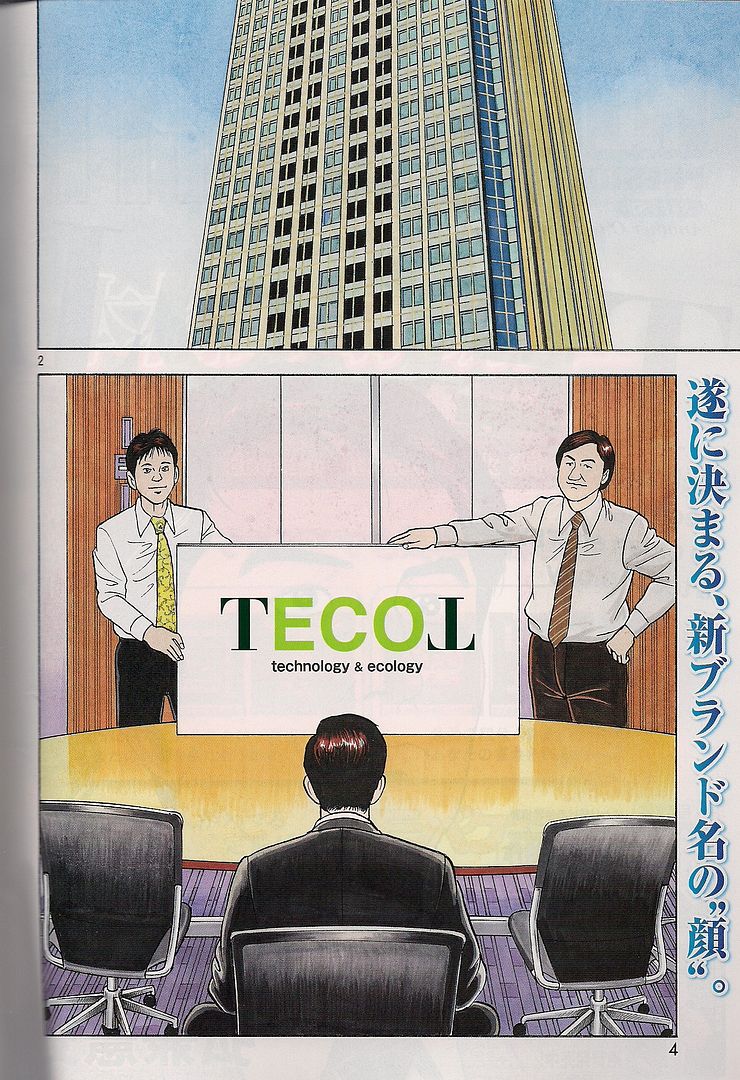
(That's right, there's exactly four pages of color comics in this 454-page issue of Morning, and one of them just went to a pair of saucy motherfuckers presenting a logo to President Shima Kosaku, 'cause that's just how they roll in the big boy seinen weeklies, and if you don't like it you can piss right back off to CoroCoro, asshole-kun.)
TS: That Comic-Book Comics thing is one that I've seen in every single used book store, there's always a bunch of beat up copies. Sometimes they look like they're beat up in the same exact way, makes me wonder if they came from one specific place, or if it's some famous supposed-to-be-destroyed print run.
I haven't actually kept up with those Popeye reprints, but I plan to. There's something about large sized comics, even when the price isn't that high - maybe it's the New York mentality, not wanting to carry shit around.
JM: Yeah, I can just stash it in my car. Which I also fill with diesel fuel, unrefined oil. Which I dig up myself, illegally. Then I watch NASCAR with one eye.
TS: I've got a lot of love for NASCAR.
JM: Yes?
TS: Theoretically. I like the concept quite a bit. I don't actually watch it. But I like the idea that I could.
***
(forward to part 2)
Labels: BCGF

<< Home